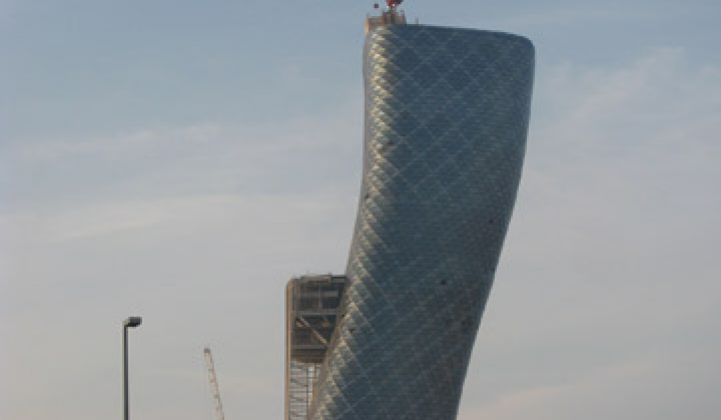To improve efficiency in a 10,000-square-foot datacenter managed by NTT in San Jose, Vigilent shut off nine of the 14 air conditioners.
Power consumption went down dramatically. But so did the ambient temperature.
The counterintuitive effect -- you’d think the temperature would rise at least a few degrees with fewer AC units -- derives from the way that air flow changes for the worse as the number of AC units rises.
“An air conditioner is a heater in a crowded environment,” said president and founder Clifford Federspiel.
Diagnostics and analytics will likely be the two most popular buzzwords in the rapidly growing building management market over the next few years. Although building management systems have been around for years, it has only been in the last several that we've started to see more sophisticated software for mining all the disparate data that will also automatically tweak machinery to conserve power consumption.
Vigilent (formerly Federspiel Controls) applies artificial intelligence and predictive analysis -- the same sort of algorithms behind search engines -- to air conditioners. Its software crunches information about the temperature, humidity, power consumption and other factors and then creates a dynamic model for efficient cooling.
“We extract an ability to predict the future from current data,” Federspiel said. “The software knows the impact of what will happen if you change a temperature setting or a flow control.”
There are two things to note about this trend. First, this new wave of hyper-intelligent control and diagnostic systems can achieve pretty impressive results. SkyFoundry, one of the faster growing companies in this space, is deploying its technology platform into two major retail chains. One these chains has 1,100 stores.
In the first 250 stores, the software saved $2 million in four months, said president John Petze, noting that this approach is fairly cheap compared to the usual army of consultants required for efficiency retrofits.
“You can get started [with SkyFoundry] with thousands of dollars, not hundreds of thousands of dollars," Petze said. SkyFoundry was founded in 2009 and only started shipping products in 2011.
Second, everyone’s business model sports a slightly different shade.
Vigilent concentrates on managing air conditioners, with a primary focus on AC units in data centers. It does not touch lights or control computing loads and modes. Data centers occupy only 2 percent of the total square footage of corporate real estate, but consume 20 percent of all energy purchased, says Vigilent CEO Mark Housley.
In a data center owned by the Franchise Tax Board, Vigilent eliminated 60 percent of the power consumed by circulating cold air. Overall, the company’s technology has been deployed in over 50 data centers containing 1,000 air conditioning units. So far, 400 of these AC units have been shut off, saving 75 million kilowatt-hours of energy per year.
By contrast, Scientific Conservation Inc. concentrates mostly on commercial office space and industrial sites rather than data centers. While it focuses primarily on HVAC data today, the company hopes to analyze data from lights and other appliances in the future. The underlying secret sauce derives from neural networks, a programming concept developed in the '80s. SCI creates an ideal model of how the building should function, compares it to real data, and draws conclusions on what needs to be fixed.
SCI, however, won’t control devices directly. The company’s software sits on top of a building management system and provides it with information, so it’s more like a persistent Accenture consultant for office parks.
Serious Materials, meanwhile, mines data coming off of plug loads to determine what is working properly and what isn’t. The system then assumes “supervisory control” over an existing building management system. In other words, the software lets you take fairly direct action and doesn't just provide advice, Serious execs argue.
Instead of selling software licenses on a per-square-foot basis like some companies, Serious sells it as service. The rack rate is ten cents per square foot a year -- and the company claims it can achieve energy reductions of 20 percent. If a company spends $2 a square foot on energy each year, Serious saves 40 cents per square foot, keeps ten cents and delivers a 30-cent-per-square-foot savings to the owner or tenant. (Serious used to concentrate on building materials like green drywall, but shifted into controls when it purchased Valence Energy last September.)
Petze, meanwhile, chafes if you call SkyFoundry’s technology an application. It’s an analytics platform, he emphasizes. It can take in a wide variety of data -- old utility bills from a spreadsheet, meter data, weather data, energy consumption from the HVAC -- and create energy conservation plans.
Ideally, however, customers and partners will create customized applications that will refine SkyFoundry’s capabilities, similar to how developers at publishing firms customize apps for particular websites. Every building is different. A meat locker and an ad agency might exist next door to each other in the same city, but their needs will be different.
Like Serious, SkyFoundry is looking at ways to “white label” its technology through channel partners.
In some cases, the similarities are greater than the differences. But, as in solar electronics, we’re living in an era where these concepts and business models will be honed and refined on an ongoing basis.



